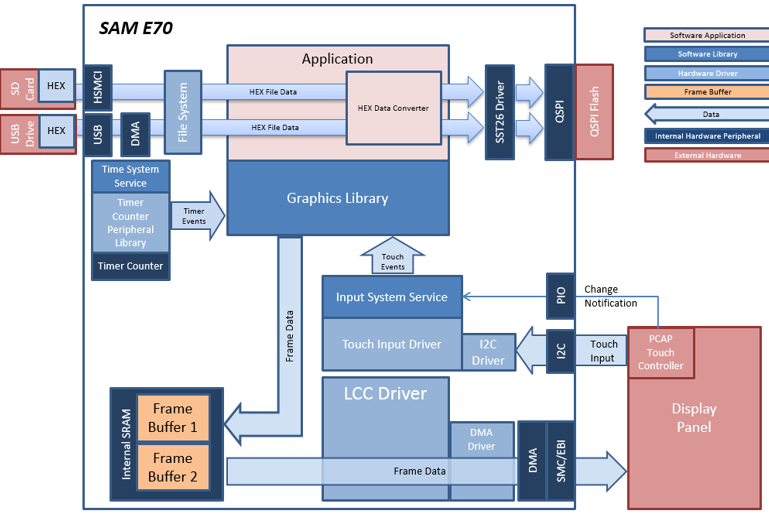
The aria_flash application uses the USB file systems in MPLAB Harmony and the USB driver to scan the MSD for a .hex file with resources and reads them sector by sector and programs the external non-volatile SQI memory. The Graphics Library is used to render graphics to the display. Using the DMA, the Low-Cost Controllerless (LCC) Display Driver continuously transfers frame data from the frame buffer out to the LCD display.
The application also features user touch input through the integrated touch screen on the display panel. Touch input from the touch controller goes through the I2C port, and the Input System Service acquires the touch input information from the Touch and I2C drivers. The Input System Service sends touch events to the Graphics Library, which processes these events and updates the frame data accordingly.
This configuration runs on the SAM E70 Xplained Ultra with RGB565 GFX Interface board and WQVGA display. Two frame buffers are stored in the internal SRAM in a double buffer configuration, and the Low-Cost Controllerless (LCC) display driver is used to manage the DMA that transfers the read frame buffer contents to the display via the EBI peripheral. The buffers are swapped when the Graphics Library has finished writing to the write buffer.
User touch input on the display panel is received thru the PCAP capacitive touch controller, which sends a notification to the Touch Input Driver. The Touch Input Driver reads the touch information over I2C and sends the touch event to the Graphics Library thru the Input System Service.
The USB peripheral is setup in MSD Host mode with the File System service support. It scans for a file named SQI.hex when a USB MSD device is connected.
The SD Card reader on the MEB-II is connected to the PIC32MZ DA starter kit via the SPI peripheral with the File System service support. It scans for a file named SQI.hex when an SD card MSD device is connected.
The application reads the hex data from the file and decodes it with a hex decoder into binary data. The binary is written to external non-volatile memory via the QSPI peripheral configured with the SST26 driver.
• Aria Graphics Library
• Input system service and touch driver
• Time system service, timer-counter peripheral library and driver
• Low-Cost Controllerless driver with global palette support
• 16-bit RGB565 color depth (8-bit palettized double buffering)
• EBI peripheral library and driver
• I2C peripheral library and driver
• SST26 QSPI driver
• USB MSD driver (Host Mode)
• SD Card driver (supported via SPI)
• File System
• Images and Fonts for user interface stored in internal flash
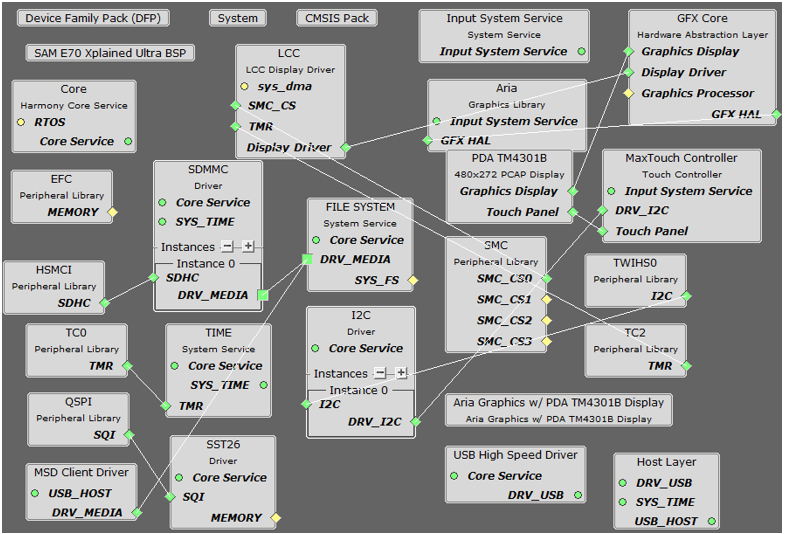
The Project Graph diagram below shows the Harmony components that are included in this application. Lines between components are drawn to satisfy components that depend on a capability that another component provides.
Adding the “SAM E70 Xplained Ultra BSP” and “Aria Graphics w/ PDA TM4301B Display” Graphics Template component into the project graph will automatically add the components needed for a graphics project and resolve their dependencies. It will also configure the pins needed to drive the display and the touch controller.
For the GFX Core component enable double buffering. (Global Palette Mode is enabled and grayed out since it is inherited from the Aria Graphics Library component.)
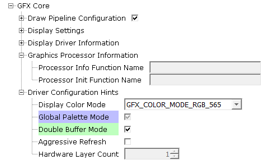
Additional components to support USB, QSPI, HSMCI and SDMMC Driver needs to be added and connected manually.
Some of these components are fine with default settings, while other require some changes. The following is a list of all the components that required custom settings.
Disable VBUS function for USB High Speed Driver
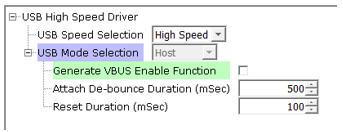
For SPI Flash access, make sure all 6 pins for QSPI is mapped.

To support the SD card reader with the HSMCI peripheral, map the pins as shown.

To drive the USB peripheral, make sure UPLL is enabled with the 40x multiplier, with USB FS Clock output 48 MHz.
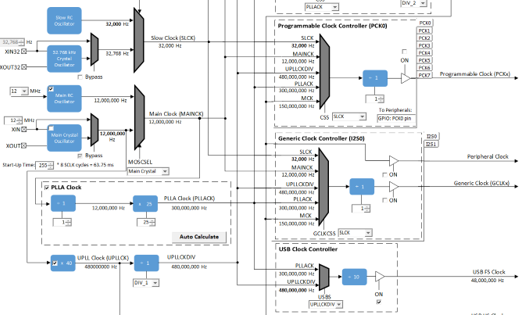
In MPLABX, open the project in gfx_apps\apps\aria_flash\firmware
|
Project Configuration Name |
BSP Used |
GraAria Graphics w/ PDA TM4301b Displayphics Template Used |
Description |
|
aria_fl_e70_xu_tm4301b.X |
SAM E70 Xplained Ultra |
Aria Graphics w/ PDA TM4301b Display |
SAM E70 Xplained Ultra with 4.3” WQVGA PCAP Touch display |
 Important! |
This application may contain custom code that is marked by the comments // CUSTOM CODE ... and // END OF CUSTOM CODE. When using the MPLAB Harmony Configurator to regenerate the application code, use the "Prompt Merge For All Differences" merging strategy and do not remove or replace the custom code. |
Connect the hardware as following:
Configuring the 4.3” WQVGA Display requires disconnecting the ribbon cable that connects the display to the interposer board.
This section provides information on how to run and use the application.
When power-on is successful, without a USB MSD device attached to the ‘Target USB’ posrt the demonstration will display a screen with the message “No valid storage mediums found. Please insert a USB device”:
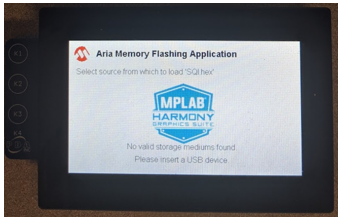
Connect a USB MSD device or SD card at the slots indicated in the picture. Note the SD card reader is on the underside of the board.

If a valid USB MSD device is connected, the display will show a USB button. LED1 (green) will light up.
If a valid SD Card device is connected, the display will show a SD Card button. LED2 (orange) will light up.
Make sure the USB or SD Card MSD device has FAT32 file system format and a valid external resources file named precisely ‘SQI.hex’ is copied inside.
Press and release the USB or the SD card button on-screen. The application will initiate the data transfer on release of the button. Depending on the size of SQI.hex file (greater than 500 kilobytes), the application may freeze with no visual feedback, upwards of 30 seconds. It will then display a progress bar to indicate the transfer. The transfer completes when the progress bar is filled. The application will then display a button with ‘OK’.
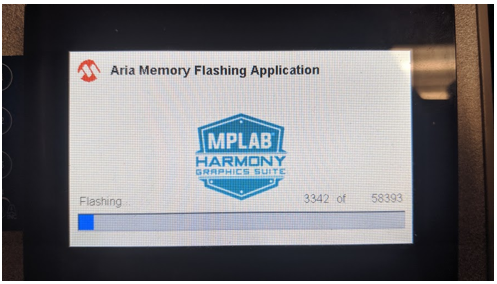
|
MPLAB® Harmony Graphics Suite
|